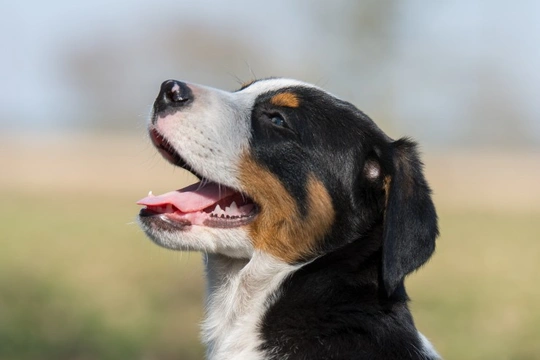
Postoperative haemorrhage disorder (P2Y12/P2RY12) DNA testing for the Greater Swiss mountain dog
The Greater Swiss mountain dog is a large dog breed from the Kennel Club’s working group, which is one of several mountain dog breeds recognised within the UK and across the world.
This isn’t a dog breed that is hugely common within the UK and in fact they’re way down as the 170th most popular breed here out of a total of 244 different dog breeds and types, and so many dog owners won’t have seen one before, or might not recognise dogs of the breed out and about.
Greater Swiss mountain dogs are very personable dogs that can fit in well with all sorts of different homes and lifestyles, but they are a very high-energy dog breed, which is matched by a high level of intelligence. This means that the Greater Swiss isn’t a good choice of pet for everyone, but for dog owners that understand large, intelligent and active dog breeds, Greater Swiss mountain dogs can achieve a lot, and they are notably good at all manner of canine sports.
They are also excellent with children and very loyal to their families, as well as making for excellent guard dogs and watch dogs too.
Dogs of the breed tend to be hardy and outgoing and not prone to picking up a lot of minor ills, but there are quite a few hereditary health conditions that can be found within some Greater Swiss mountain dog breed lines, and which can affect both the longevity and quality of life of affected dogs.
One hereditary health condition that can be found in some Greater Swiss mountain dogs is called postoperative haemorrhage disorder (type P2Y12/P2RY12), and this is a potentially very serious blood clotting disorder that has significant implications for the care and management of affected dogs.
In this article we will explain what Greater Swiss mountain dog postoperative haemorrhage disorder is, how it is inherited by dogs, and how to find out the status of your own dog with DNA testing.
Read on to learn more about Greater Swiss mountain dog postoperative haemorrhage disorder.
What is postoperative haemorrhage disorder (P2Y12/P2RY12)?
Postoperative haemorrhage disorder (P2Y12/P2RY12) is an inherited bleeding disorder that affects the blood’s platelets, which are a vital part of wound clotting and healing. When a dog is injured, platelets clot together to close the wound, end the bleeding, and begin the healing process.
However, Greater Swiss mountain dogs with postoperative haemorrhage disorder have faulty blood platelets, which means that any injury or bleeding that the dog acquires either internally or externally won’t clot properly, which can result in haemorrhaging and a potentially life-threatening loss of blood.
This can happen any time the dog has a wound or bleeding injury, but poses a particular risk for dogs that undergo surgeries, hence the condition’s name.
Greater Swiss mountain dogs with postoperative haemorrhage disorder will look perfectly normal and otherwise enjoy good health, but they may be prone to developing spontaneous bleeding in a variety of different situations such as when teething, or if the dog acquires just a small cut or graze, as well as resulting from surgery.
Stopping the bleeding and clotting the wound can be challenging, and this means that postoperative haemorrhage disorder in the Greater Swiss mountain dog can be very serious and even life-threatening.
How do Greater Swiss mountain dogs inherit postoperative haemorrhage disorder?
Postoperative haemorrhage disorder (P2Y12/P2RY12) in the Greater Swiss mountain dog is a hereditary health condition, which means that a dog can only develop the disorder if they inherit the genetic markers for it from their parents.
Postoperative haemorrhage disorder (P2Y12/P2RY12) in the Greater Swiss mountain dog is passed on from parent dogs to their offspring by means of autosomal dominant heredity, which means that only one of a dog’s two parents needs to have the condition themselves in order to pass it on to their young.
This is in contrast to the more common autosomal recessive mode of heredity, which requires input from both sides of a dog’s parentage to dictate status, and which can mean that even an affected dog could have a healthy litter.
Whilst not all Greater Swiss mountain dogs that have postoperative haemorrhage disorder will pass the condition on, there is a 50% chance that they will – for each pup they have, regardless of the status of the other dog within the mating match.
Getting a Greater Swiss mountain dog DNA tested for postoperative haemorrhage disorder
As an autosomal dominant condition, postoperative haemorrhage disorder in the Swiss mountain dog can be passed on to subsequent generations of dogs very easily, and spread quickly throughout a breed population if dogs that are affected by the condition are bred from.
Whilst postoperative haemorrhage disorder in the Greater Swiss mountain dog generally presents with very obvious and often acute symptoms in affected dogs any time they bleed, such dogs look perfectly healthy the rest of the time, and so you cannot tell by their appearance if they are affected or not.
This means that if you are intending to breed from your Greater Swiss mountain dog, you should first have them DNA tested to ensure that they do not have postoperative haemorrhage disorder and so, will not pass it on. The other dog within the mating match must also be tested too.
To get a Greater Swiss mountain dog DNA tested for postoperative haemorrhage disorder (P2Y12/P2RY12), you just need to ask your vet to take a DNA sample from your dog for testing. This can be in the form of either a buccal swab or blood vial – however, a buccal (cheek) swab is usually preferred, as this is non-invasive, and does not come with the risk of bleeding that can occur in dogs with bleeding disorders if a blood sample is taken.



